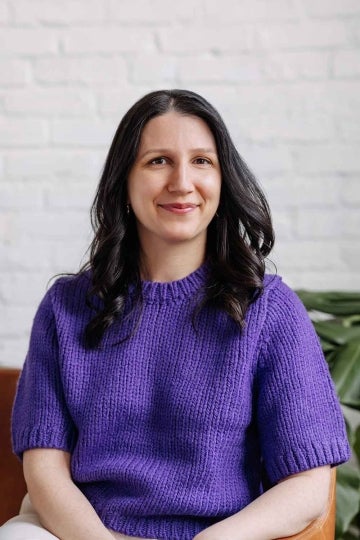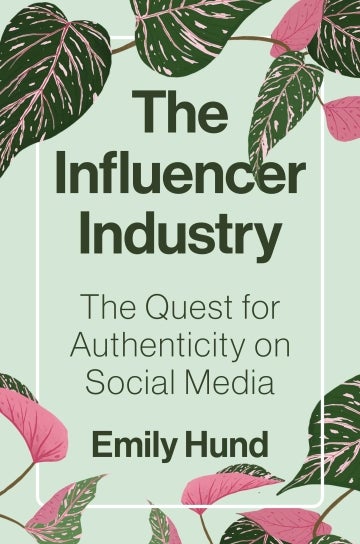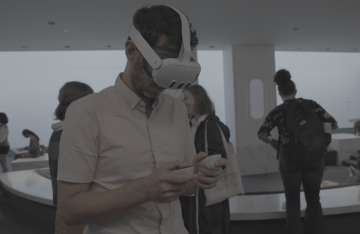The Influencer Industry: Q&A with Emily Hund (Ph.D. ‘19)
In her debut book, Hund details the history of the online influencer and the growth of a multimillion industry built on sunsets, impeccable fashion, and the illusion of effortless perfection.

Center on Digital Culture and Society research affiliate Emily Hund started her career working for magazines in New York City.
She worked a series of lower level jobs, which she hoped would be her foot in the door to the world of fashion publishing.

But the world changed quickly. Traditional publishing was dealing with the after-effects of the 2008 recession — empty desks and limited resources — and the rise of the blogosphere.
“As our economic system crashed, it fanned the flames of deep skepticism of society’s established institutions,” she writes in her book, The Influencer Industry: The Quest for Authenticity on Social Media. “People were hungry for content, but from providers who were ‘real’ — who showed that they ‘got it’ in a way that New York-based and national global media companies, from Condé Nast to The New York Times to the major television networks, never did. Marching into the vacuum came bloggers.”
When Hund began her Ph.D. program at the Annenberg School for Communication, she cast a critical eye on the rise of blogging and how it affected the media labor market and, in turn, popular content. In the years since, she’s watched the concept of “bloggers” expand to “influencers,” buoyed by the social media platforms that give them direct access to the global audience.
In turn, she examined the business of being an influencer: how they made money, how they were interacting directly with sponsors, and the incredible amount of invisible labor it all took.
In the wake of the publication of The Influencer Industry (Princeton University Press, 2023), we spoke to Hund about the book:
It seems that recently social media content has switched from being aspirational to more casual — normal people being normal. Is that something you've noticed?
Yes, definitely. I think there are many factors at play here.
Part of the allure of the influencer industry, even from the get-go, was the idea that these people were just like us, but somehow just a little bit cooler. They've always touted this identity as being, ‘I'm like you. I don't work for a major magazine or website. I'm more like you than like them.’ And the truth in that varies, but that has always been a big selling point for influencers.
For the longest time, the paradox was that these people are supposedly like us, but they present their lives in a very curated way. Their images are so edited and posed — they have a very specific aesthetic. There was this ideal of perfection that was being displayed, especially on Instagram, throughout the 2010s.
A lot of things changed in the late 2010s and early 2020s that have pushed things in a different direction. The launch of Instagram Stories in 2016 was a really big one, because with Stories, it’s not about prepping for a photoshoot and making this really beautiful content. You can just turn it on and talk to the camera while you’re walking. That was huge.
And TikTok has taken that to the extreme. Even though many TikToks are staged and rehearsed, they give the appearance of, ‘I'm just turning on my camera and going for it.’
What else has changed?
When the influencer industry first developed, around 15 years ago, there had been a growing distrust of traditional media institutions, growing distrust of the government, religion, and traditional pillars of society. It was quite alluring to see people who seemed to know what they were talking about, but were also just like us.
And now after the last few years — particularly with COVID and political unrest — it’s like we've gone through another cycle of that. Even more people have found new reasons to feel distrust of the media, government, and other major institutions, and there are more platforms available for people to use to present themselves as experts.
Ten to 15 years ago, only about a quarter of adults in this country ever used social media. Now around 90 percent do. And of course, way more people have smartphones now than they did then, enabling this constant connection to these platforms.
I think all of this has led to a heightened desire for this supposed authenticity.

In the book, you explain that in order to succeed in the influencer industry, influencers have to know how to market themselves as “authentic.” How does that work?
The influencer industry is a constellation of individuals and companies that work together and compete with each other to make influence legible as a product. It includes social media companies, brands, marketing firms, and individual influencers (or people who aspire to be influencers).
Authenticity in this situation is an industrial construction shaped by the needs of the various stakeholders of the industry more than anything else.
If you talk to individual influencers, they might say, ‘I really was making that for dinner and I wanted to film it and show people,’ but they were doing it in a way that they knew would be legible to audiences and advertisers because of sort of the reigning norms of what authenticity looks like.
How did your research evolve during your time at Annenberg?
By the second year of grad school I realized that what I was researching wasn’t really about the fashion industry or even the traditional media industry as we think of it — it was its own industry.
After I had that realization, it eventually became clear that what’s being used to evaluate influence is this other concept of authenticity. So then my research went to authenticity.
What did you learn?
I had done all this work charting the history of influence, how people thought about it over time and how it became a quantifiable product. The work of Elihu Katz, who was at Annenberg, was of course a touchstone. And I thought, ‘This is about influence and how our understanding of influence has changed over time.’ I knew the concept of authenticity was important, but I wasn’t sure how to approach it in a meaningful way.
But conversations with people from Annenberg — my professors and fellow students, my advisor Joe Turow, visiting scholars like Sonia Livingstone and Susan Douglas — pushed me to consider other factors.
Through the process of writing the dissertation proposal and preparing to write the dissertation, I came to really understand how I could talk about authenticity in a new way that was not only adding to the academic and theoretical conversations about authenticity, but also accessible, too. In my fellowship at CDCS, I was given the space and time to continue this work and ultimately write the book manuscript.
People often see being an influencer as a frivolous hobby, but for many, many people, it’s their full-time job. How do we set standards for this industry as it evolves?
I think that we need to recognize the influencer industry for what it is, a commercial industry that needs to be regulated as such. From a labor perspective, I think influencers need to recognize their working conditions as working conditions and that they deserve pay and protections.
There is no professional body within the industry like other cultural industries have — like the Society of Professional Journalists or the Association of National Advertisers. Professional bodies like that help organize and govern the industries, to set standards for best practices and ethical codes.
I think there needs to be better regulation and more consistent consequences for people who run afoul of basic rules like ad disclosure and labor laws. Influencers who are doing their jobs above board are essentially tiny advertising agencies. So why not treat them as such?
I think that would benefit society at large for us to better understand who influencers are and what they are doing and why they do it — just like how society had to acclimate a hundred years ago to the existence of mass advertising.
When we see a TV commercial, we understand that this TV commercial is trying to sell us something. We need to get to a place where the public has a much higher level of understanding of influencers and of the sponsored content that they see in their social media feeds.
I think that influencers themselves and social media companies and brands all have a role to play in educating the public.



